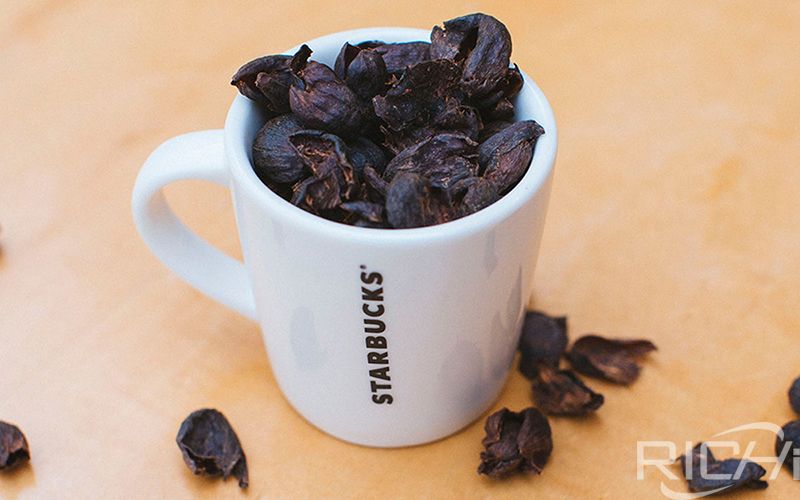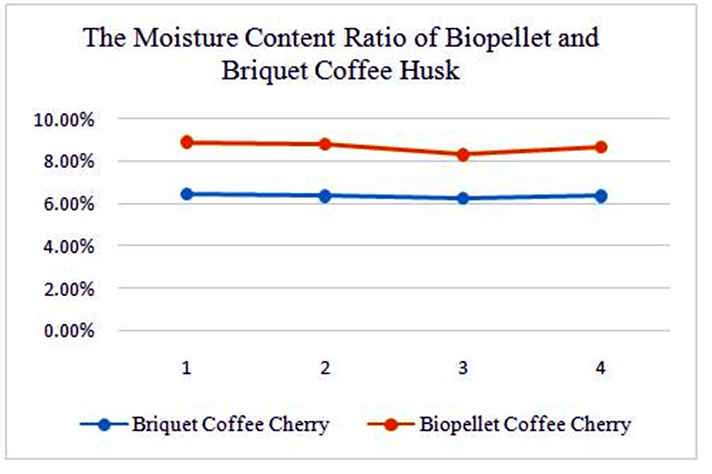
This is where you find all our press releases and news articles.
Coffee husk is a residual product from coffee cultivation. It is widely used for extracting caffeine and tannin, composting. Besides these, it is also a suitable material for pellet making machine to replace coal and fossil fuel. Brazil is the biggest coffee production area around the world and there are several and increasing number of power plant is using coffee husk pellets for electricity generating.

Analysis on the project of making burning pellets from coffee husk
As we all know, dense,high calorific value and easy to process, wood sawdust is the most suitable material for biofuel pellet plant. Coffee husk has the similar element with wood sawdust. Although not as good as wood sawdust, coffee husk is still a good materials for making pellets. Coffee husk is in uniform size and shape, so it's easy to be processed into biomass pellets.
For proper analysis, the materials were dried in the sun to reduce their moisture content to at least less than 12% (w/w). The sizes were then reduced to a uniform particle of 1 mm diameter. The proximate analysis parameters included moisture andash contents, volatile matters, and fixed carbon. The result of the analysis was as presented in table 1 below.
| Type of Analysis | Parameters | Result (%) |
| 1 | Water content | 2.25 |
| 2 | Ash content | 0.73 |
| 3 | Volatile matters | 74.20 |
Table 1: The proximate analysis of raw materials of coffee husk.
The moisture content and volatile substances reduced during carbonization process. Contrastingly, fixed carbon content and the calorific values increased. Besides, the moisture content evaporated at high temperature even during storage. This was attributed to environmental conditions due to its hygroscopic nature.
| m1 (g) | m2(g) | m3(g) | Moisture Content (%) |
| 1.003 | 0.914 | 0.089 | 8.900 |
| 1.006 | 0.918 | 0.088 | 8.800 |
| 1.008 | 0.925 | 0,083 | 8.300 |
| Average | 8.670 |
Table 2: The moisture content.
The moisture content has influence on net calorific value, combustion efficiency, temperature, and its equilibrium. Moreover, the ambient moisture content was affected by storage conditions. The results of moisture content analysis were as presented in table 2. It is prudent to note that the moisture content of the biopellet ranged from 8.30% to 8.90% (Figure 1).

Figure 1: The ratio of moisture content biopellet coffee husk.
There was a difference in the initial moisture content of the coffee husk briquette and biopellet. The preliminary value of briquettes in the hot air chamber when using drying machine was much lower compared to the solar drying sample. While using moisture analyzer, the content was 8.67%. This was different from the one in briquettes within the hot chamber air that had 6.34%. Moreover, the difference in value between biopellet and briquettes of coffee husk was 4.62%. It is imperative to note that the moisture value of biopellet was meant to fulfill the New Europe Pellet Standard-EN 14961-1. Notably, the higher moisture content required more energy to evaporate water. The needed energy to ignite the biopellet increased, causing the fuel to react during combustion. With a higher moisture content, the quality of biopellet decreases.
To determine ash content,it is important to analyze the unburned part without carbon element after the combustion of the biopellet (Table 3).
| Replication | W1 (g) | W2 (g) | Ash (%) |
| 1 | 0.2107 | 3.0075 | 7.005 |
| 2 | 0.2495 | 3.0330 | 8.266 |
| 3 | 0.2740 | 3,0508 | 8.981 |
| Average | 8.071 |
Table 3: The ash content of biopellet coffee husk.
The gross calorific value is an important parameter when determining the fuel quality. Its values in the biopellet was 16.897MJ kg-1, established using the LECO AC-350. This was considerably lower than the European Pellet Standard-EN 14961-1 required for the production of commercial biomass. It is required to range between 17.500 and 19.500MJ kg-1 (Table 4).
| Paremeter | Replication | ||
| 1 | 2 | 3 | |
| Weight (g) | 1.01 | 1.01 | 1.01 |
| Fuse wire 1 (cm) | 9.80 | 10.01 | 10.01 |
| Δ Fuse wire (cm) | 6.41 | 7.22 | 7.51 |
| Δ T (pre-fire) (° C) | 1.68 | 1.62 | 1.70 |
| Oxygen (Psi) | 420.00 | 420.00 | 420.00 |
| Calorific value (cal/g) | 3951.50 | 3932.90 | 4230.10 |
Table 4: The calorific value of coffee husk biopellet.
The lower calorific value was brought about by high moisture content which slowed down the rate of combustion. This is essentially because it had to evaporate water, thereby lowering the calorific value.
While using the furnace method, the value of ash content in coffee husk biopellet was 8.071%. During production the pellet is expected to have the lowest ash content. Nevertheless, the value obtained in the study did not satisfy the set requirement, 0.5%, by the New Europe Pellet Standard-EN14961-1. Further, high ash content (beyond 4%) could corrode the burners and abrade equipment. Since heat from the sun alone was not enough to produce the product that satisfies the set standards, the highwater content of the material affected the value of ash content.
Coffee husk pelletizing is similar to other biomass materials, including: drying, crushing, pelletizing by coffee husk pellet machine, cooling, and packing. However, to process premium coffee husk pellets, we have two tips of guidance for coffee husk pellets starters.
A. To cutting down the production cost, you should choose a place which is close to raw material production area to processing coffee husk pellets.
B. As different biomass materials are with different component content, the pellets calorific value are also different. To get a higher burning calorific value.
These pellets are advantageous in comparison to the other biomass pellets because of numerous factors. These factors include:
These pellets are capable of producing a high heat value in comparison to the pellets of agricultural waste.
The cost of production of these pellets is low as the materials are available in abundance due to the huge production of coffee in various places. The machines that are used for the process of pelletizing the coffee husks and coffee grounds are also not very expensive.
The agricultural wastes and the forestry residues are collected from the paper plants, croplands, sawmill, and furniture factory, whereas coffee husks and grounds are the leftovers of the cultivated land or brewed coffee. This product does not cause any harm to the human body.
With a large market demand, coffee has a broad production area around the world. One of the famous coffee cultivation countries is Brazil. Brazil country's availability of land, water and labor has allowed coffee increased production and exports. Annually, Brazil could produce upwards of 150,000 tons of coffee husk. Besides Brazil, Coffee also has a wide planting in Colombia, Indonesia, Vietnam, etc. Coffee husk can be transformed into a value-able fuel -- coffee husk pellets and becoming an important local energy source. In Brazil coffee husk is mainly used in power plant for the purpose of electricity generating. There are still a amount of coffee husk pellets used for home heating etc.
Having the right mix of reliable, high-quality pellet machine and pelletizing systems and expert support is essential to your success. Watch how our end-to-end feed pellet plant solutions have helped our customers optimize their performance.
Our customized and future-proofed turnkey pellet plant solutions is designed with you at the core. From vision to reality and beyond, our team stays connected with yours. Giving you peace-of-mind with an expert at your side.

At RICHI, we go beyond project completion. With RICHI Servicee, we’re your dedicated partners in success. Count on us for expert guidance, minimal downtime, and optimized productivity. Choose RICHI for unmatched service and support.



Meet global product demands and quality standards with industry-leading pellet plant design, engineering, equipment, and construction services for pellet processors.


Your Partner Beyond Project Completion
2000+ cases
RICHI is the leading designer, manufacturer and builder of pellet plants in the world, completing over 2000 projects in 140 countries across 6 continents.
Read More
Increase plant productivity, profitability, and safety by integrating high quality equipment into your pellet production line. Over the years, RICHI has become China's top pellet equipment manufacturer. At the same time, RICHI has established valuable partnerships with the world's leading component and raw material manufacturers to bring you the best there is in technology, automation, and efficiency in pelleting plant machinery.

For nearly 30 years, RICHI has been providing best-in-class pellet plant equipment and services to clients across a variety of industries, sizes, and needs. We pride ourselves on the knowledge and skill that each team member possesses – from our technical sales team to our process design engineers. You can count on RICHI Machinery to take your operation to the next level of innovation, quality, and success.
Need help with your pellet manufacturing plant project? Contact us today.
ANIMAL FEED
BIOMASS
WOOD
ORGANIC FERTILIZER
AQUA FEED
CAT LITTER
MUNICIPAL WASTE RECYCLING
SPECIAL PELLET PRODUCTION
RICHI Machinery continues to deliver world class pellet mill equipment, pellet plant engineering and project solutions that add value to our customers in the animal feed, wood waste, agriculture waste, organic fertilizer, cat litter and special pellet products industries. Throughout the years, we RICHI Machinery have built strong brand, becoming industry-leading pellet machine manufacturer. We value integrity, promise quality, and prioritize your success.
Learn MoreWith our expert team, we precisely implement your process engineering requirements in pellet mill and pelletizing plant systems. No matter which industry you’re in – we understand your needs and deliver solutions that meet the highest standards.
At RICHI, quality comes first. Our pellet making machine and related pellet line equipment undergo rigorous quality controls to ensure they meet the highest standards. Rely on products that are durable, safe, and efficient.
With decades of experience in pellet machine and pellet production line production, we have earned a reputation as a trusted partner in various industries. Our expertise allows us to cover a wide range of applications.
Not only do we offer premium pelleting equipment, but we are also experts at designing, building, installing, and maintaining facilities from the ground up. Our expertise is within pellt plant process design, discovering the most efficient, productive, and profitable way to handle your materials in an end-to-end cycle.
○ RICHI MACHINERY
Keeping in touch with us is an effective way to solve all your problems. If you have any needs or questions, please leave your contact information, then RICHI technical consultants will send design, quotation, videos to your mailbox. You can also contact us directly via WhatsApp: +86 13838389622
Copyright©2015-2026 by HENAN RICHI MACHINERY CO., LTD. All rights reserved.